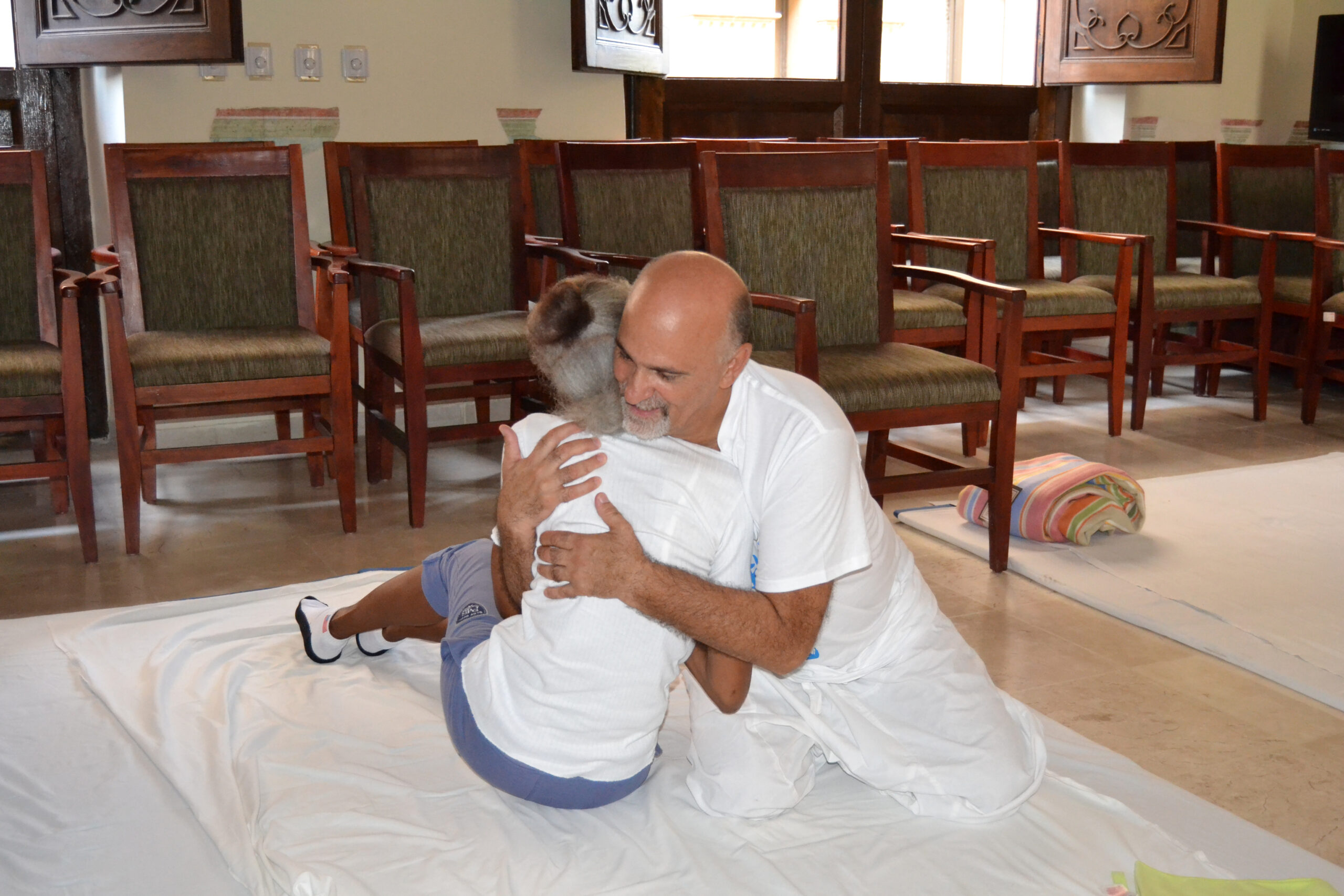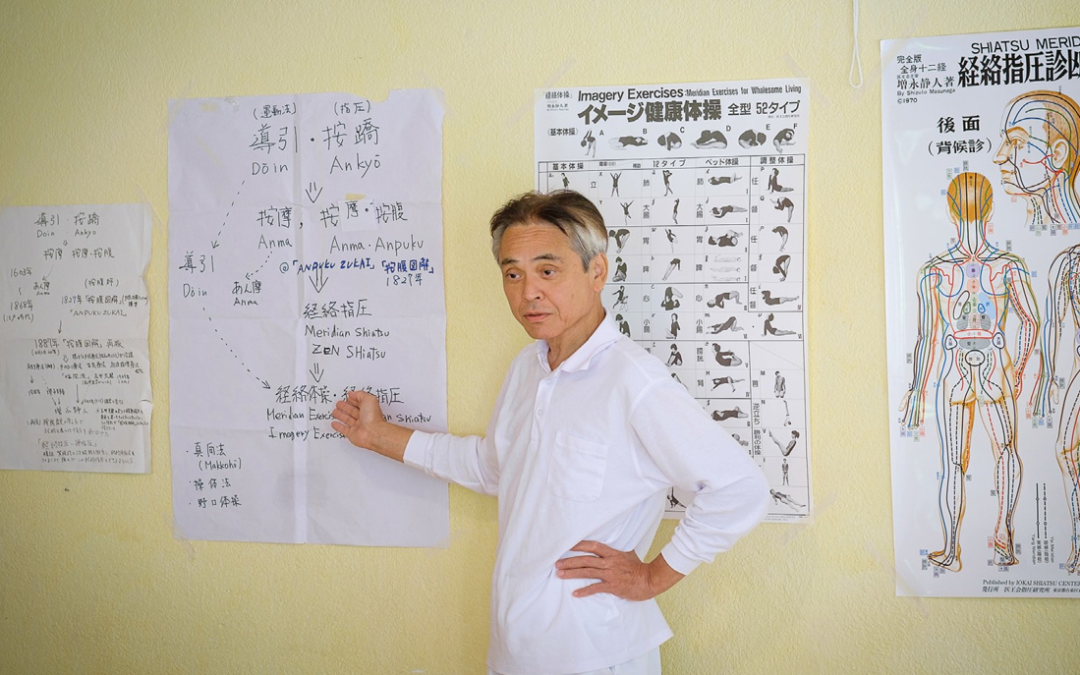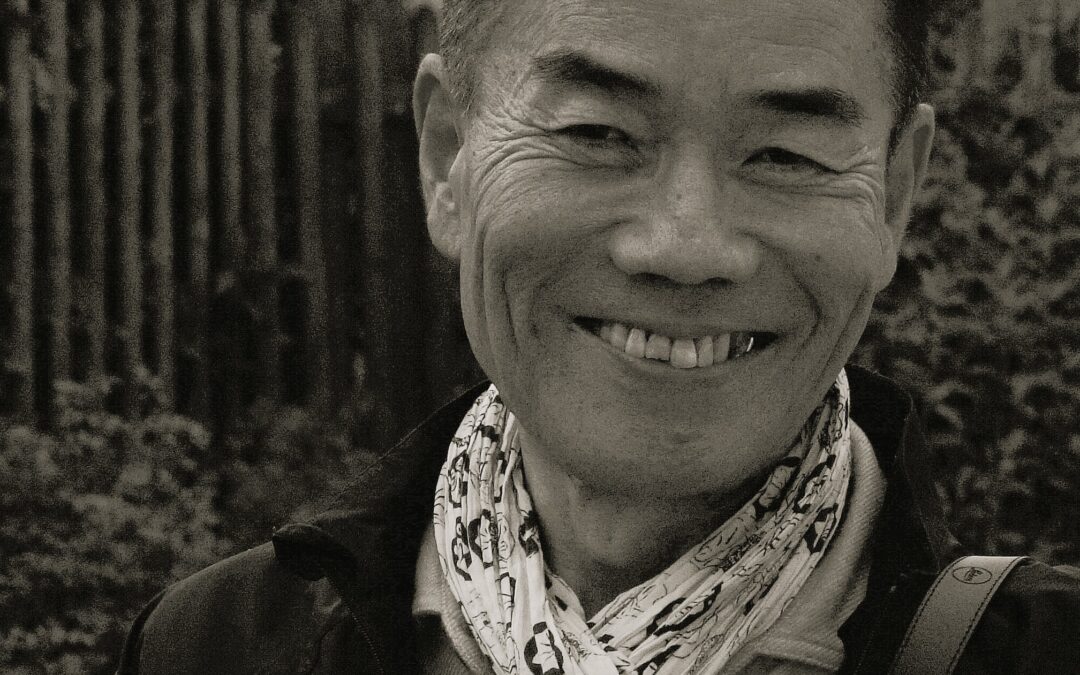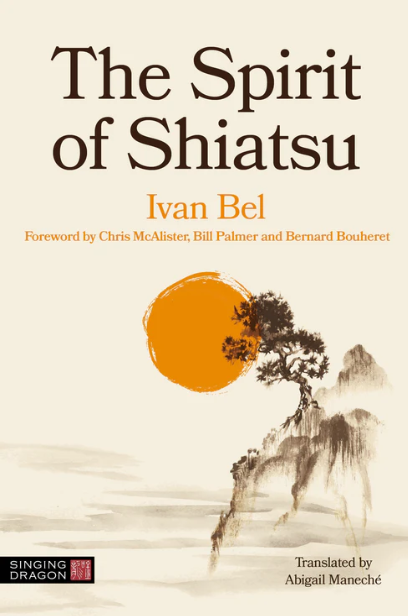We are privileged to have in the Shiatsu world some truly fascinating people. One of them is Bernardo Corvi whom we will introduce during the course of this interview. Shiatsu practitioner, teacher, expert writer on the subject and finally an entrepreneur. Not only is he a tireless traveller, a hard worker, but most importantly, he has especially put his Shiatsu knowledge at the service of the disadvantaged. Let us consider the following for a second: prisoners, prostitutes, crooks, Buddhist monks and priests… he takes care of everyone without making any distinction. For him, every human being deserves to be helped.
Ivan Bel: Hello Bernardo Corvi. I am extremely pleased to hold this interview because you are truly an amazing person. As an entrepreneur, you have developed the “Tatamiportable.com” brand, but that is not what interests me today. I would like to talk about the many things you have done and the social dimension that animates you through Shiatsu. Could you start by telling me who you are, where you come from and how Shiatsu became part of your life?
Bernardo Corvi: Hello Ivan, thank you for the opportunity you have given me. My name is Bernardo Corvi, I live in Italy, in a small rural village called Lesignano de’ Bagni, in the Parma province. It was in the beginning of the 80’s that I was introduced to Shiatsu, I would say by chance. Until the early 90’s I used my own pressure technique which I practised only sporadically, as a self-taught person. In the middle of the 90’s I improved my training within one of Europe’s most representative Shiatsu schools: the Accademia Italiana Shiatsu Do. I immediately felt the enormous psychological, social and human potential that this art offered as an opportunity. It fascinated me from the very first moments of practice. The Shiatsu practice opened me to new opportunities and possibilities for intense and profound human relationships.
Historically speaking, I know that Italy was the first European country where Shiatsu started. Do you know the first Italian who introduced it? Did you meet him personally?
The first person who introduced Shiatsu in Italy was Rodolfo Palombini[i], who was the first European to bring this technique outside of Japan. In 1964, as he was following the Italian teams at the Tokyo Olympics, he attended the Nippon Shiatsu College in Namikoshi. In 1981 he founded the Italian School of Shiatsu in Rome, which is now run by his son Fulvio[ii].
The reference figures for Shiatsu in Italy are Master Yuji Yahiro, who since February 1974 started to practice and promoted the study of Shiatsu at the “Bu sen” Centre in Milan. It was in this centre in 1975 that one of the fundamental figures of Shiatsu in Italy also started his studies: Mario Vatrini[iii]. A true researcher, he had brilliant ideas, making valuable inputs and offering revolutionary contributions to the practice of Shiatsu in Italy.
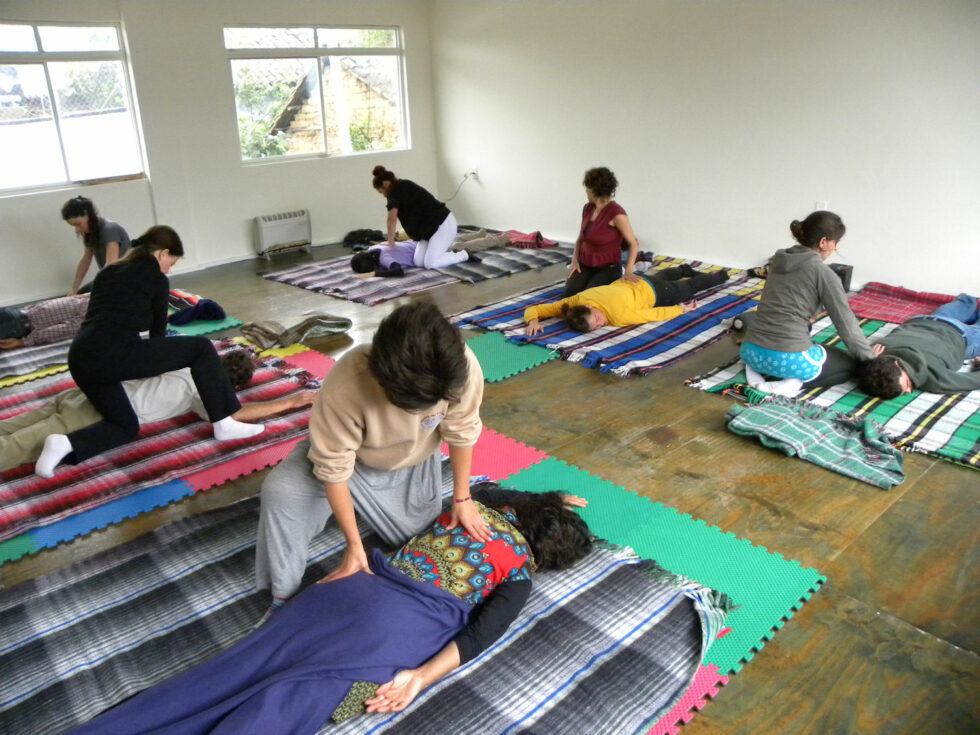
I met Yahiro-san and attended a seminar facilitated by him and took part in a seminar in 2004 where Rudy Palombini’s son, Fulvio and Mario Vatrini were present among others.
As of today, Shiatsu is quite common in Italy and its level is known to be one of Europe’s best. What is the situation of Italian Shiatsu now? Are you recognized as a public interest by the State?
In Italy, Shiatsu is an open activity. The Shiatsu professional is not required to have any diploma nor enrolment in specific registers, colleges or associations. There are no constraints that can prevent access to the profession and anyone can practice this activity. Unless he/she decides to make the practice of Shiatsu his/her professional activity, he/she will have to comply with the regulations concerning tax obligations, contributions, respect of privacy, etc. Those obligations are not mandatory for those who intend to practice the discipline as a hobby, area of personal interest, and voluntary work without receiving any compensation.
In Italy, April 2013, a law has been promulgated which embodies the reference legislation for “professions not organised in affiliations or colleges”, or even “associative professions”, and provides the possibility of setting up private associations for professions without an official register. The law is enacted in accordance with the principles of the European Union on fair competition and free trade.
The three most important professional associations of Shiatsu in Italy are: APOS, COS, FISIEO, which require certain conditions to be recognised by the MISE (Ministry of Economic Development). As described above, although membership inside an association is not compulsory for the profession, they represent the face of the Shiatsu profession towards the State. Thus, providing accountability for the quality of the training as well as the necessary clarity to make the client feel confident when receiving a Shiatsu.
Let’s come back to you. Shiatsu was such a revelation for you that you decided very early on to offer it beyond the Italian borders, giving courses in Mexico, Cuba and at the University of Brasilia. Please tell me about this. How did it happen?
As I got into practice, I found that the quality of my life increased in parallel. I felt and still feel satisfied and excited every time I place my hands and practice Shiatsu with people. Each contact is a new, intense and intimate experience that often transcends states of consciousness.
Through voluntary practices I discovered that Shiatsu could enter all those places where doors would most probably not open, especially areas of severe social distress. While being in charge of the school, I was also managing the training that took place in my region and I had the opportunity to organize, also thanks to my students, various volunteering experiences. Those were practices in psychiatric structures and jails, but also for instance, providing ‘fieldwork” Shiatsu to the victims of the earthquake in Emilia-Romagna in 2020, while people were relocated in temporary tent shelters.
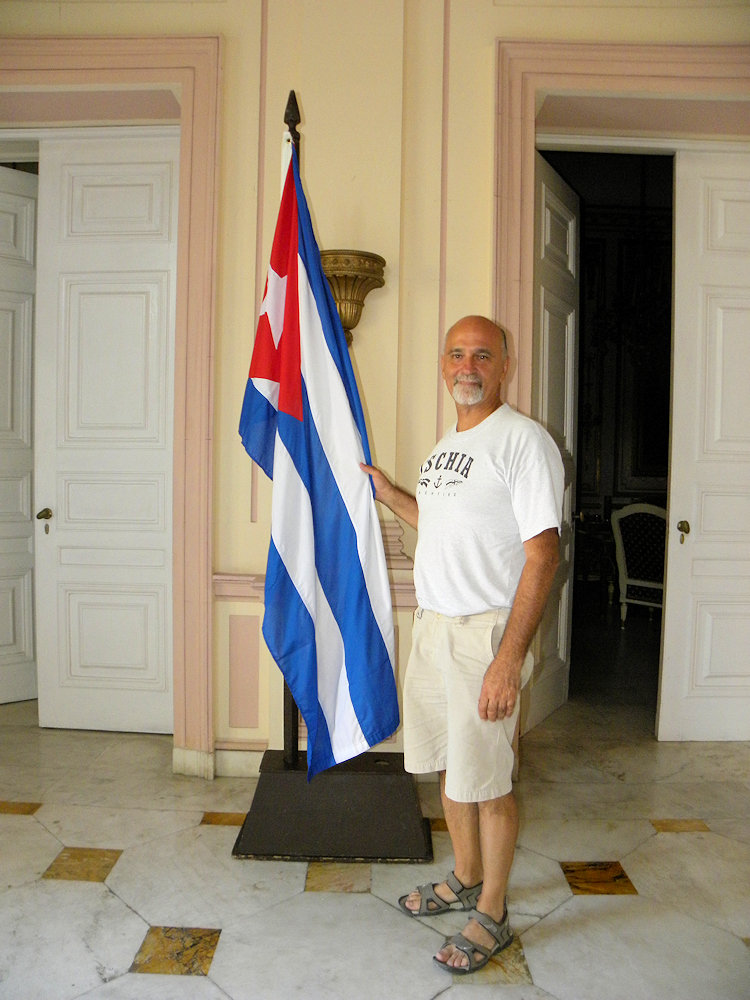
However, it was a specific event that brought me to Brazil. I was quite involved in the projects of a former association, Shiatsu Do volontariato, which in turn, was supporting missions in Brazil through the “FLY” initiative (Felipe de Lyon). The “FLY” was managed by Donna Vittoria Garofalo, who passed away a few years ago, and who Mario Vatrini met while he was travelling to undergo his studies of the trance conditions in Umbanda [iv]. The project aimed to provide school education and a daily hot meal to children in a town located a few hours’ drive from Brasilia: Palanaltina de Goyas. At that time, I was working on my first book, a book of poetry, inspired by the inner movement born from my practice. A tragic event, the death in dramatic conditions of Valentina, aged 18, daughter of my closest collaborator and colleague, led me to ask myself how to carry on the great work of this girl and her mother, who decided to be organ donors to save the lives of others. I found a publisher who was receptive to the cause and we printed copies of the book, donating all the profits to the project in Brazil. This opened the doors to my own enriched journey there, taking advantage of a Shiatsu training initiated by a Brazilian instructor from our school, where I acted both as a supervisor and as a “senior” instructor and which led us to hold some sessions with students from the Faculty of Physiotherapy of the University of Brasilia.
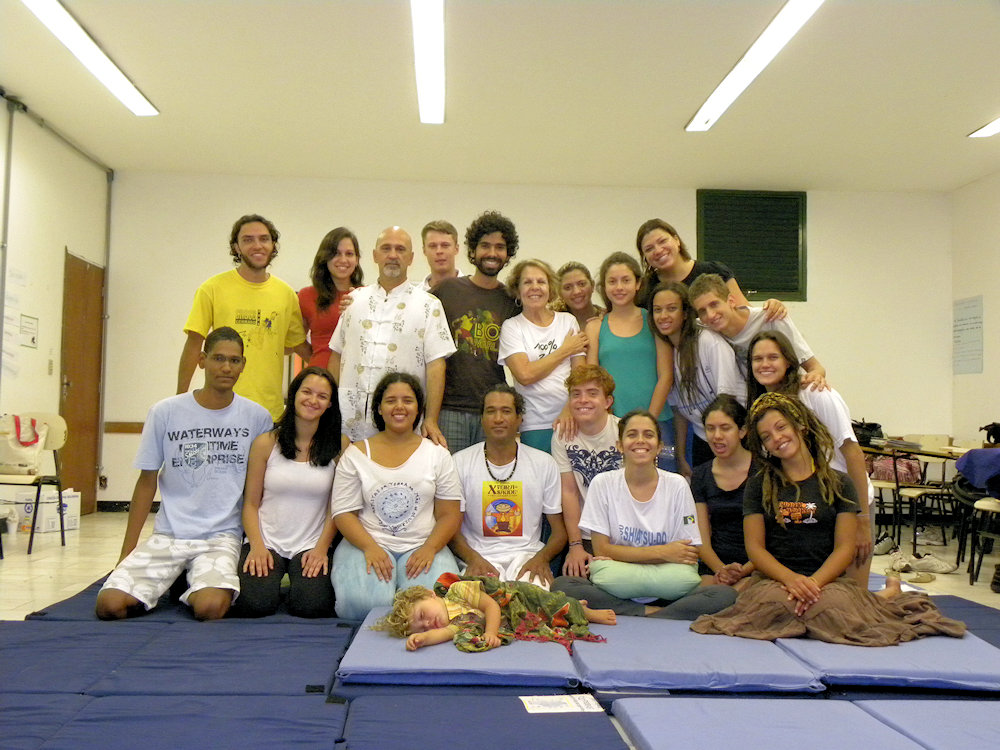
All my subsequent books, which addressed different aspects of my practice, followed the mission dedicated to Valentina and, again, all profits were always donated to support various volunteer projects in Italy and abroad. Supervising the training of some of these projects took me to San Cristobal de las Casa, Chiapas, and La Habana, Cuba. I speak about our experience, written by myself and a colleague living in Cuba, in another book (see list of books at the end of this article).
This is incredible! What a story! Another important initiative of yours was to open the first Shiatsu course in the world in a residential facility for mentally ill people who have committed crimes. This is impressive! One might be afraid of such people, but apparently you were not. How did you proceed with the management of the place while looking as well after these people? What were the results?
The project of carrying out a Shiatsu course at the REMS (Residence for the Execution of Security Measures) of Casale di Mezzani (Parma) was born from the willingness of the ARS (Regional Health Agency)[v] of Parma to include the practice of Shiatsu in its educational programmes for the guests of the institution. The effectiveness of this program had already been tested during more than fifteen years of treatments recognised by the Directorate of Mental Health and Pathological Addictions. The organisation in the Casale di Mezzani facility, which began in September 2015 (the year this facility opened), and was also renewed for the following years, effectively provided treatment for all the patients. No exclusions!
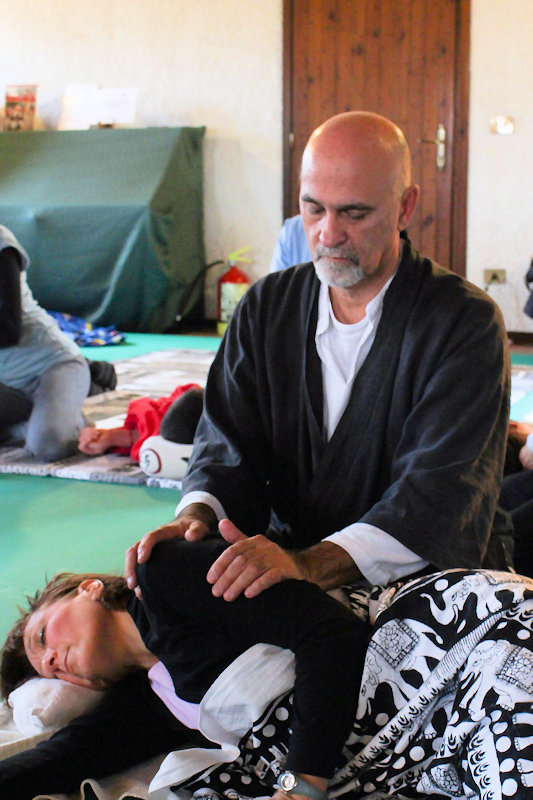
The law 81 of 2014 created a health-care institution in Italy that has not been matched in the rest of the world. The journey began more than 40 years ago, with the famous Law 180 of 1978 which ruled the closing of psychiatric hospitals. With this law, an era ended, that of the penal treatment of the insane. According to the Italian Constitution, anyone who has been judged incapable of understanding and willing at the time of committing an act that constitutes a crime cannot be prosecuted. Until the law came into force, psychiatric patients who committed crimes were incarcerated in facilities called “Judicial Psychiatric Hospitals” which were in fact criminal asylums. These are places where, paradoxically, those who have committed a crime caused by their pathology find themselves serving a heavier sentence than those who have committed the same crime without pathology. The REMS are not judicial structures but health structures in which people are taken care of by the competent magistrate and meet specific requirements. The main mission of these facilities, which are community psychiatry, is based on the principle of “recovery” and the main project is the implementation of an individualised therapeutic project aimed at rediscovering and enhancing the unique capacities of each individual. The main aim of the structure, in addition to guaranteeing the security of care for those who need it (as stipulated in the constitution), is their reintegration into society, helping to break the social danger resulting from the committed act.
The course, as one could assume, was an experimental course open to the operators and guests of the facility and led to exceptional results, which I will report in my next book: “A special state of being, psychological, social and human aspects of Shiatsu practice in the social field”, both for the receivers and the givers involved in the project but also for the manager of the facility. A futuristic journey that deeply touched our motivations, fears and anxieties and gave intense emotions in return, overcoming barriers and biases by making us discover the person rather than his crime.
Was it this experience that led you to give treatments in the prison environment, in the “La Pulce” jail in the Emilia-Romagna region?
No, in fact it is the opposite, it is thanks to the experiences of volunteering both in prison – first in the Beccaria prison for minors in Milan and then in the Reggio Emilia one – and my work in Shiatsu treatments carried out for many years in the psychiatric field, that I had the skills to get involved in such a great project as REMS; to carry out the treatments before and after the course. The projects in prisons were born thanks to the competence of one of my colleagues in Milan with regard to teenagers’ supervision and to the willingness of one of my students, employed in the municipality of Reggio Emilia, who expressed his intention to bring our treatments to prison. At that moment I accepted and thanks to the collaboration between us, I with my skills, he with his knowledge, and thanks to the Councillor’s interest in the social policies of the municipality, we drew up a project with the prison warden. The great human aspect of these experiences will also be reflected in my next book.
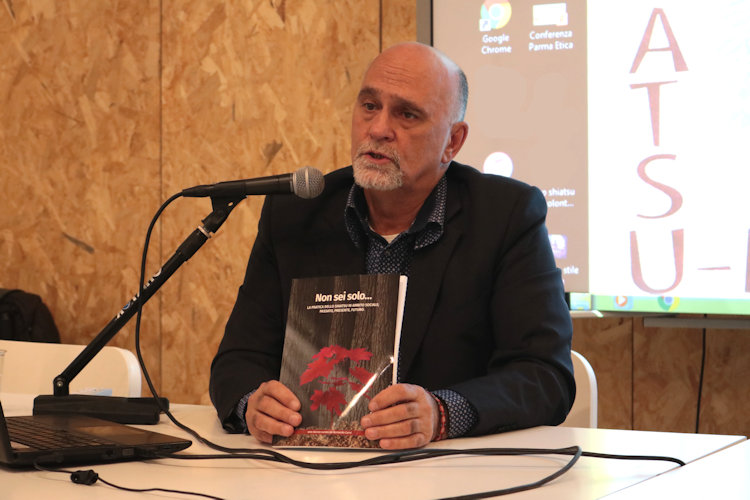
One could say that your experiences are all moving in the direction of the opening of the Heart. And then in May 2012 the terrible earthquake in Mirandola, still in Emilia Romagna, occurred. I remember that people died, many injured and above all many buildings destroyed. What did you do when you heard about this situation?
Once again, it is the collaboration that allows us to think of such great support projects. The role of trainer is a mission that offers broad horizons both for the students – giving them the opportunity to have very intense experiences which can be seen as in a certain way deeply spiritual – and for the growth path of the teacher himself. It is very rewarding to make yourself available to help the students accomplish their dreams if you know that you have the skills to achieve them together. This is the mission of the teacher, to identify what resides in the souls of his fellow travelling companions, to check its consistency and feasibility and to give birth to the Heart led experiences, as you rightly pointed out. A discipline thus becomes a life experience. Organising our presence in the improvised tent camp in Mirandola was tiring work that involved moral and spiritual motivations as well as physical stamina. We provided support to people who had lost everything but found themselves, if only for a few moments, in a bubble of peace and serenity. We practised in tents provided by the civil defence, thanks to the sponsorship of the municipality of Mirandola, where, even with air-conditioning, the temperatures rarely fell below 50 degrees. More than 70 practitioners from all over Italy, from all schools, were involved. The project led to the writing of the book “The Angels of Shiatsu” (see end of article), now out of print.
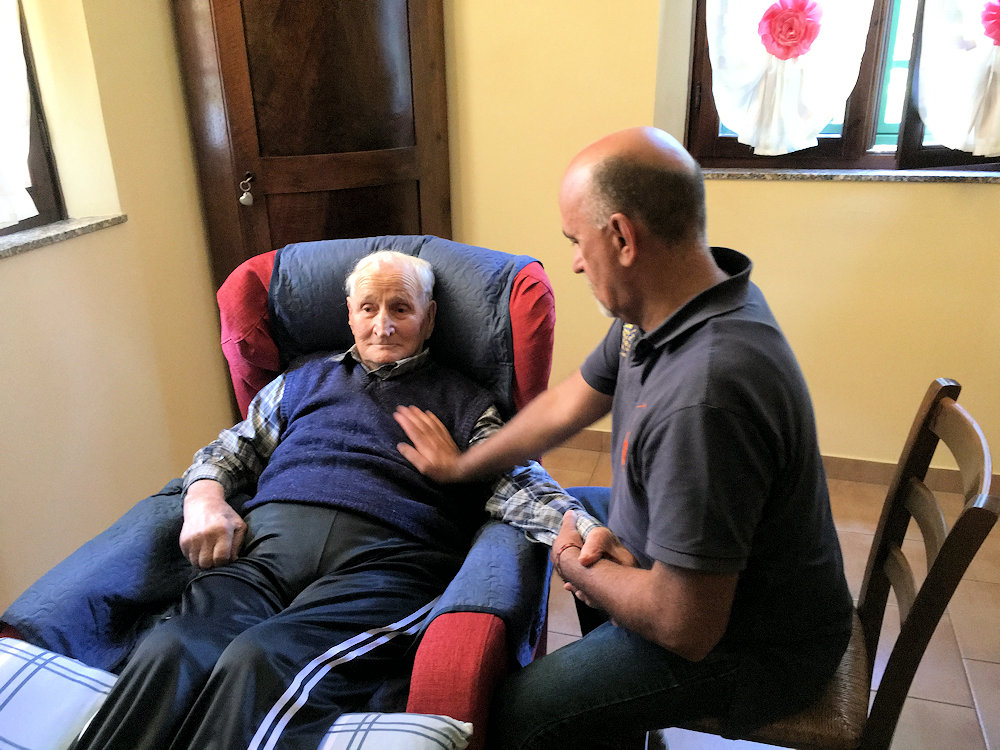
I can imagine that living under the constraints of an emergency situation must have been both a difficult time humanly speaking, but at the same time an amazing adventure seeing what Shiatsu can do for people in distress. From a professional point of view, what were your takeaways from this new experience? Has it changed your Shiatsu?
You are right, practising Shiatsu in a context of suffering, whether it is populations or individuals in difficulty, makes us understand the true importance of the discipline which is thus transformed into an art. Without any doubt, Shiatsu is a technique which, by using pressure brought via the palm of the hands, the thumbs, the forearms and the elbows brings benefit to the muscular tensions and to the discomforts of all kinds, stimulating the innate vital force of each person. But since years in Italy we are starting to think about a non-therapeutic Shiatsu, that we could call a “Shiatsu of Values”. Shiatsu’s effectiveness emerges precisely from the intimate relationship established between the two people involved in a treatment, allowing for a better condition according to each person’s own potential, time and methods.
However, this could certainly answer the fact that Shiatsu is an ever evolving discipline. The life improvement generated by this practice, influenced as well by the stimuli following gentle pressure on the body, is deeply linked to the fact that both people are actors, in a constant flow of mutual reciprocity, leading to a relationship allowing the expression of the best part of each individual, a genuine relationship. The path is then open to allow the emergence of a deep, intimate, transformation leading to a higher state of consciousness. Shiatsu, then, is defined undoubtedly, as an encounter, an instant “out of time” allowing the arising of a spontaneous and subtle conversation, with its own unique code away from traditional verbal code. A language which is thoughtful, respectful and, above all, a language of listening. A language that is attentive, polite and, above all, listening. Sometimes, a way of expressing oneself that, free from rudeness and superficiality, is able to reach deep layers of consciousness.
I have always agreed with my friend Francisco Contino, project manager in Cuba[vi], when he defines that “Shiatsu is not a massage, but a message”. The way of doing Shiatsu evolves pressure after pressure, experience after experience, and relationship after relationship. If there is a Shiatsu for well-being, there is also a Shiatsu for alleviation. Well-being is within the reach of many, but relief, on the other hand, might be a very difficult state to reach for others, who have always been engaged in a difficult path of discomfort which can be physical, social, human. So here is a Shiatsu that listens, not seeks, that adapts, not imposes change, which perceives the meaning of its own touch.
Through your life as a Shiatsu practitioner, we can see how much the social and humanitarian dimension lives in you, and I must say that I find this magnificent. Today you give specific seminars on “Shiatsu in a context of severe social distress”. Can you briefly tell me about it?
It may sound strange, but the seminars I give outside of the training field are not about teaching new techniques, where many colleagues are much more competent than I am, but rather about personal development through the practice of Shiatsu. I bring you the comment of a practitioner from Rome, which seems to me the most representative. He said: “I have attended many seminars with many very good teachers, but this seminar is the only one which brought me back to myself”.
There is no particular method of practising Shiatsu in a context of severe social distress which is not what we already do every day. In my seminars I do not propose any new or even “miraculous” strategies. The main thing is to bring us back to ourselves. That is to say, a path of awareness that allows us to use the technique we already possess to discover ourselves, together with the other, united by a desire to share emotions, states of mind, suffering, but also moments of relief. A process of rediscovering what we already know how to do, but with greater attention to recognising the softness in our hands that allows us to welcome and communicate with each other. A process that always reminds us not to impose but to listen. Not to desire, but to fly with the other, recognising them as a complementary part of us. Therefore, an inner growth is necessary that allows us to perceive, in every moment of the relationship, that the most important moment of a Shiatsu treatment is the one you are experiencing right now. Pay attention to the breathing, to the release of muscular tensions, to the feel of the weight that rests on the body of the other person and penetrates through deeply. Perceiving the depth of the body tissues, of the muscle bands, but also the depth of the feelings and of interrelationship.
Everything is also done through the proposal of meditations and, depending on the context, the recital of mantras.
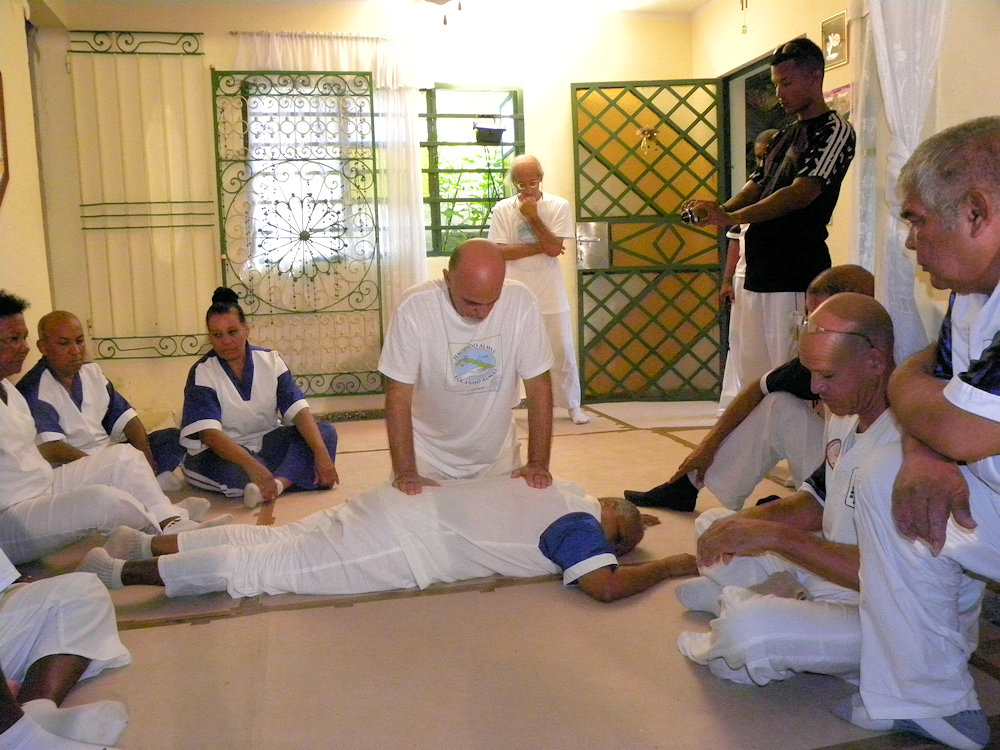
At what point in your life did you decide that, in addition to Shiatsu, you would also make tatami mats and turn them into a business?
For more than fifteen years I have been making these transportable tatamis[vii]. vii] I produce them one by one, in a small workshop I have near my house. I started because I noticed the need for students and professional operators to have a work environment that could be easily carried, light, comfortable and with a soft cover which is gentle for the knees. I tested many materials until I found the ones I am currently using that are of the highest fabric. Thanks to the fact that I used to train every day on these tatamis, I was able to design specific features, and test the qualities necessary to have a premium product. For more than fifteen years I have been producing at least 250 of them per year and I ship them not only all over Italy but also to most European countries. My tatamis are also present in Cuba, Mexico, Martinique, Brazil and other parts of the world. Being a shoemaker by trade, I knew how to sew with a machine and I still have several sewing machines. I am grateful knowing the fact that, through the use of my tatami mats, I have been a key player in the spread of Shiatsu around the globe. To know I was allowing thousands of people to practice in the most comfortable way gives me a very rewarding feeling.
When I launched the MSH platform, you were one of the first people who spontaneously contacted me to donate equipment to all practitioners who volunteer for humanitarian work. Thank you very much for this generosity. I would like to conclude this interview with a message from you, directly addressed to the French/English speaking Shiatsu community.
It is me who thanks you. When I saw the work you were doing for MSH, I felt implicated and I know that I can help people who put their heart into what they do to make their practice easier, more comfortable. It may sound strange, but when I feel that I can help people to do their work better, I feel happy. I felt how tiring it is to practice Shiatsu in extreme conditions and in this way I feel that a small part of me will be involved in the treatments you give in the course of your projects.
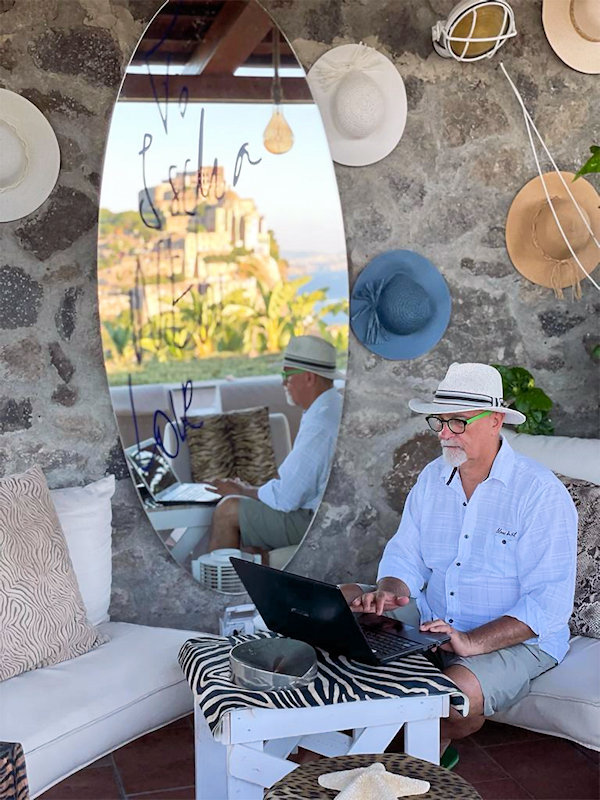
I would like to conclude with a few sentences from my next book:
“In my life I have practised with Buddhist monks, priests and seculars. I have treated men who have killed other fellow men, crooks, thieves, prostitutes. I have treated enlightened people, but also normal, everyday people. Yet… every time I had to lay my hands on each one, I never perceived any difference in their vital energy, in their deeper spirit, that “being”. It is what impregnates the ancestral soul of people and makes them, in all cases, embodied of the same identical essence present in each living being.
Every person’s heart beats, every person has blood and Qi – a fundamental concept in Chinese culture- within its body. Every person has feelings. Everyone, without exception, feels love for someone.
Humankind craves love as it faces its own path to enlightenment, to overcome hate. Noble and simple feelings that are often expressed in kind-hearted actions. “My religion is only one: kindness”, taught H.H. the 14th Dalai Lama. Acts full of intention and care, which generate recognition, and gratitude.
Gratitude is an act of love.
Thank you very much for your testimony, it is a privilege to meet someone like you.
The pleasure is mine.
Author: Ivan Bel
Translation: François-Rémy Monnier
Roberto Corvi’s Books
- Altri amici, un piccolo diario di esperienze Shiatsu in psichiatria e in prigione ; (éd. Académie italienne Shiatsu Do),
- Gli angeli dello Shiatsu ; éd. DB communication, 2013
- Incontrare il Tao a La Havana e altrove ; éd. DB communication
- Non sei solo… La pratica dello Shiatsu in ambito sociale ; éd. Mowie & Web
Notes:
- [i] Rodolfo Palombini (Rudy 1930 – 1994) introduced Shiatsu in Italy. Founder of the Italian School of Shiatsu – S.I.S. (1979), expert in massage therapy, he obtained in 1964 the first European diploma of Shiatsu-therapist at the Nippon Shiatsu School (today Japan Shiatsu College) then directed by Master Tokujiro Namikoshi. R. Palombini deepened his studies on Namikoshi Shiatsu by introducing it in rehabilitation therapy and sports traumatology. The experience gained over the years, the years of notes, tests and research led to the natural evolution of Namikoshi Shiatsu into the Palombini method, a careful codification of a system adapted to the needs of the Western world.
- [ii] In 1994, Rudy’s son, Fulvio Palombini (born 1955), rheumatologist and professor of physiotherapy at the University of Rome “La Sapienza”, took over the school. Fulvio Palombini, faithful to his training as a doctor, in the respect of his professional activity, body motor rehabilitation, works so that the scientific world turns its gaze towards Namikoshi’s Shiatsu, in order to evaluate its effectiveness through experimentation.
- [iii] Mario Vatrini died in 2007. There is only one book in circulation, written in 1998, named “Strategie di Shiatsu”. Bernardo tells me: “I have a version published by “Curcu and Genovese” editor in 2004. In the short caption on the back cover it simply says: “Mario Vatrini, a direct student of Masters Yahiro and Masunaga, has been practising Shiatsu since 1975 and graduated from the Iokai style in Tokyo in 1977. He has a Shiatsu school “Majinai”. He is known for his competence.
- [iv] In 1992-93 Mario Vatrini spent a few months in Brazil to personally experience the trance conditions of Umbanda, a syncretic cult born from the contact between traditional African religions and Christianity, close to the Cadomblé originating from Rio de Janeiro. This stay led him to get to know and deepen the relationship of friendship and collaboration with Donna Vittoria Garofalo, daughter of Italian immigrants and founder of the Fly (Felipe de Lyon) project based in Planaltina de Goyas, which aimed to provide education and a hot meal to the local children.
- [v] In Italian ASL (Azienda Sanitaria Locale)
- [vi] To learn more about this mission in Cuba, read this article in Italian. About Francisco Contino, here is what Bernardo Corvi says about him: “I wrote the book “Encountering the Tao…” with Francisco. In his presentation of the book, he says: “FRANCISCO CONTINO. When, for some reason, he had to write his curriculum vitae, Francisco realised that throughout his life he was late on taking important decisions; the classic person who only understands what he is really interested in after having wasted years doing what he is not really interested in. You could say that he suffered from a chronic time-lag. This can be said of his university studies, his work as an employee and then as a teacher, and so on with all the other important stages of his life. A trait that was repeated for his two greatest loves, Shiatsu Do and especially his daughter Annabella. The upside was that dating smarter and younger people made him feel younger than his age: the downside was that he suffered from a sense of discomfort at being so late to catch on. One day, obviously late and obviously in Cuba, he came across the 4 laws of SAI BABA spirituality, especially the third one: WHATEVER IS THE MOMENT IS THE RIGHT MOMENT. So now, when he has to fill in his curriculum vitae, he just writes: Francisco knew how to make all the important decisions in his life at the right time.
- [vii] To see the products sold, go to https://www.tatamiportable.com
- Bosnia – 5-6 April 25: 1st Balkan Shiatsu Summit in Sarajevo - 31 January 2025
- Austria – 19-21 Sept. 25: Shiatsu Summit in Vienna – chronic fatigue, burnout & depression - 19 December 2024
- Terésa Hadland interview: Shiatsu at core - 25 November 2024
- Book review: “Another self” by Cindy Engel - 30 September 2024
- Austria – 24-26 Oct. 25: Master Class in Vienna – Shiatsu and martial arts - 20 August 2024
- France – Lembrun Summer Intensive Course – July 6 to 12, 2025: Digestive System Disorders, Advanced Organ Anatomy, and Nutrition - 4 August 2024
